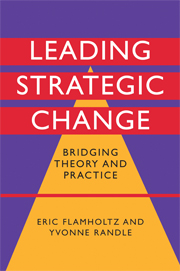Book contents
- Frontmatter
- Contents
- List of exhibits
- Preface
- Acknowledgments
- Part I An integrative framework for leading strategic and organizational change
- 1 Understanding organizational change
- 2 A framework for planning strategic and organizational change
- 3 Leading change
- Part II Leading strategic change in actual organizations
- Part III Leading strategic change: lessons learned from practice
- Appendix: References for further reading on leading change
- Index
2 - A framework for planning strategic and organizational change
from Part I - An integrative framework for leading strategic and organizational change
Published online by Cambridge University Press: 22 September 2009
- Frontmatter
- Contents
- List of exhibits
- Preface
- Acknowledgments
- Part I An integrative framework for leading strategic and organizational change
- 1 Understanding organizational change
- 2 A framework for planning strategic and organizational change
- 3 Leading change
- Part II Leading strategic change in actual organizations
- Part III Leading strategic change: lessons learned from practice
- Appendix: References for further reading on leading change
- Index
Summary
Introduction
In chapter 1 we defined change, identified common barriers to change, and presented a typology for classifying the target of change. We also described the phases in the change process. This chapter builds upon these constructs to create a framework or “lens” for developing an effective change management plan. We first present the framework and then describe how to use this framework in planning for and successfully implementing the change process. We also summarize some of the empirical research that has been done and assess its validity and usefulness in an appendix.
This framework is presented for two major reasons. First and foremost, it can be used to plan and lead strategic and organizational change. It is also important as a perspective for this book, however, because most of the case analyses of actual change efforts described in subsequent chapters are from companies that have used this framework.
Key components of the framework
The framework for planning and implementing change is based on an organizational effectiveness (or success factors) model. Derived from a combination of empirical research and “clinical” experience in working with organizations, this model identifies the key factors upon which an organization needs to focus in order to maximize long-term success. Hence, these are the factors that an organization and its management need to focus upon in the context of planning for and implementing change.
- Type
- Chapter
- Information
- Leading Strategic ChangeBridging Theory and Practice, pp. 26 - 48Publisher: Cambridge University PressPrint publication year: 2008



